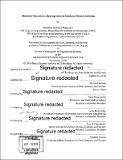Modeling transmission heterogeneity for infectious disease outbreaks
Author(s)
Majumder, Maimuna S. (Maimuna Shahnaz)
DownloadFull printable version (12.08Mb)
Other Contributors
Massachusetts Institute of Technology. Institute for Data, Systems, and Society.
Advisor
Richard Larson.
Terms of use
Metadata
Show full item recordAbstract
The transmissibility of a given infectious disease is often described by its basic reproduction number (Ro) - namely, the average number of secondary infections caused by an index case in a fully susceptible population. Typical approaches to modeling transmission dynamics associated with infectious disease outbreaks frequently use Ro to produce deterministic case count projections, in effect treating the affected population as homogeneous (i.e. as if every individual in the population interest has an equal likelihood of passing on the infection of interest). As a result, such approaches often fail to effectively capture transmission dynamics during real-world outbreaks in heterogeneous populations. Here, we use analytical and simulation methods to show that the treatment of Ro as the mean of a random variable (thus permitting the estimation of non-deterministic case count projections) allows us to better assess outbreak trajectory and likelihood of disease propagation in non-homogeneous populations (Chapter 2). We then empirically investigate predictors of in-population transmission heterogeneity (i.e. the fact that some individuals in a given population are more likely than others to pass on the infection of interest) within the context of Middle East Respiratory Syndrome in South Korea using a combination of statistical- and review-driven approaches (Chapter 3). Then, in Chapter 4, we explore how in-population transmission heterogeneity can be used to our advantage through the deployment of risk-informed interventions (i.e. in which individuals who are more likely to pass on the infection of interest are exclusively targeted to receive the intervention) during infectious disease outbreaks. More specifically, we use the analytical and simulation methods first introduced in Chapter 2 - paired with inpopulation transmission heterogeneity data from Chapter 3 - to compare the utility of a variance-informed deployment scheme against a traditional, uniform deployment scheme (i.e. in which every individual has an equal likelihood of receiving the intervention). Finally, building off of our findings in Chapters 2, 3, and 4, we recommend four interrelated policies in Chapter 5 that aim to (1) normalize the treatment and reporting of Ro as the mean of a random variable and (2) improve access to the data required to sufficiently capture population heterogeneity when modeling disease propagation.
Description
Thesis: Ph. D. in Engineering Systems, Massachusetts Institute of Technology, School of Engineering, Institute for Data, Systems, and Society, 2018. Cataloged from PDF version of thesis. Includes bibliographical references.
Date issued
2018Department
Massachusetts Institute of Technology. Engineering Systems Division; Massachusetts Institute of Technology. Institute for Data, Systems, and SocietyPublisher
Massachusetts Institute of Technology
Keywords
Institute for Data, Systems, and Society.